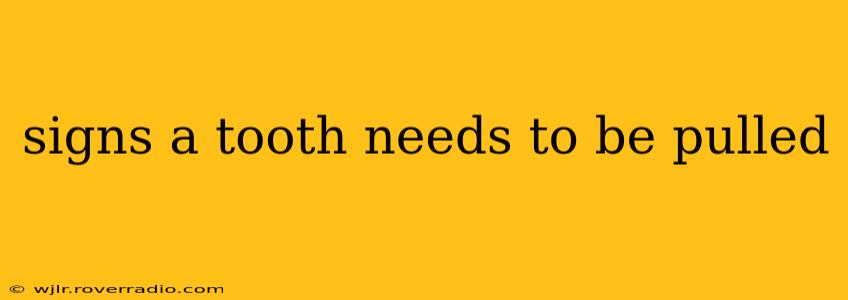Losing a tooth is never ideal, but sometimes extraction is the only solution to preserve your oral health. Understanding the signs that indicate a tooth needs pulling is crucial for preventing more significant dental problems. This comprehensive guide will explore various indicators, helping you determine when professional intervention is necessary.
What are the Signs a Tooth Needs Pulling?
Several factors contribute to the decision of whether or not a tooth needs extraction. It's not always a simple yes or no answer; rather, it's a careful assessment by a dentist considering various factors. Here are some key signs:
Severe Tooth Decay or Infection
Extensive cavities: When decay penetrates deep into the tooth, reaching the pulp (the soft inner part containing nerves and blood vessels), it causes intense pain and infection. If restorative treatments like fillings or root canals are not viable options due to extensive damage, extraction might be necessary.
Abscess: A painful, pus-filled swelling at the root of the tooth is a clear sign of infection. This requires immediate dental attention, as the infection can spread to other parts of the mouth and body. Extraction may be necessary to eliminate the source of infection.
Gum Disease (Periodontitis)
Advanced gum disease can severely damage the supporting structures of the tooth (the bone and ligaments). If the bone loss is significant, the tooth becomes loose and unstable, making extraction the only practical solution to prevent further complications and potential spread of infection.
Impacted Teeth
Impacted teeth are those that are unable to erupt properly through the gums. Wisdom teeth are the most common examples. If an impacted tooth is causing pain, infection, damage to adjacent teeth, or cysts, removal is often recommended.
Tooth Trauma
A severely damaged or fractured tooth that cannot be repaired may necessitate extraction. This is especially true if the fracture extends below the gum line or involves significant damage to the root.
Orthodontic Needs
In some cases, a tooth may need to be extracted to make space for proper alignment of other teeth during orthodontic treatment (braces). This is often a planned procedure discussed with your orthodontist.
Tooth Damage from Extensive Restorative Work
A tooth with extensive fillings or crowns may eventually become weakened and prone to fracture. If the tooth structure is compromised to the point where it cannot support further restorations, extraction may be the best option.
How Can I Tell If My Tooth Needs Pulling?
This question is best answered by a qualified dentist. While the signs above can indicate a potential need for extraction, a proper diagnosis requires a professional examination, including X-rays. Don't attempt self-diagnosis or home remedies. A dentist can accurately assess the condition of your tooth and recommend the most appropriate treatment.
What Happens During a Tooth Extraction?
Tooth extraction procedures vary depending on the complexity of the case. Simple extractions involve removing a visible tooth, while more complex extractions may require surgical intervention to remove impacted or broken teeth. Your dentist will discuss the procedure and any necessary anesthesia beforehand.
What Should I Do If I Suspect I Need a Tooth Extraction?
Schedule an appointment with your dentist immediately. The sooner you seek professional care, the better the chances of preserving your oral health and preventing more severe problems. Early intervention can often lead to less invasive and less costly treatment options.
This article is for informational purposes only and does not constitute medical advice. Always consult a qualified dental professional for diagnosis and treatment.
